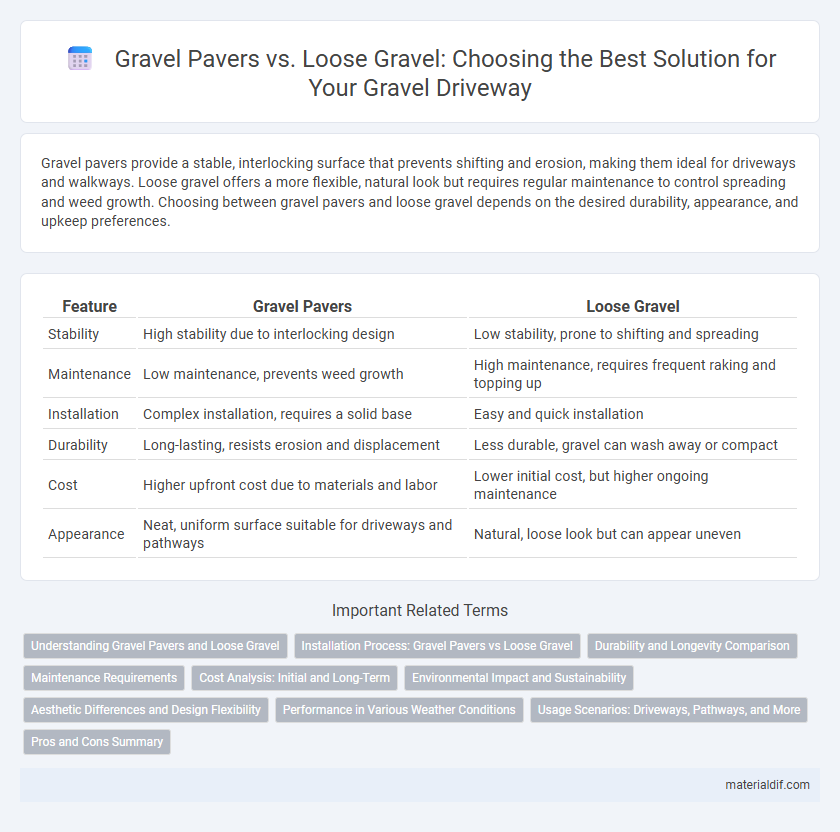Gravel pavers provide a stable, interlocking surface that prevents shifting and erosion, making them ideal for driveways and walkways. Loose gravel offers a more flexible, natural look but requires regular maintenance to control spreading and weed growth. Choosing between gravel pavers and loose gravel depends on the desired durability, appearance, and upkeep preferences.
Table of Comparison
| Feature | Gravel Pavers | Loose Gravel |
|---|---|---|
| Stability | High stability due to interlocking design | Low stability, prone to shifting and spreading |
| Maintenance | Low maintenance, prevents weed growth | High maintenance, requires frequent raking and topping up |
| Installation | Complex installation, requires a solid base | Easy and quick installation |
| Durability | Long-lasting, resists erosion and displacement | Less durable, gravel can wash away or compact |
| Cost | Higher upfront cost due to materials and labor | Lower initial cost, but higher ongoing maintenance |
| Appearance | Neat, uniform surface suitable for driveways and pathways | Natural, loose look but can appear uneven |
Understanding Gravel Pavers and Loose Gravel
Gravel pavers are interlocking units designed to stabilize loose gravel, providing a durable surface that reduces erosion and enhances load-bearing capacity for driveways or walkways. Loose gravel consists of small, irregular stone pieces that offer natural drainage but require frequent maintenance due to shifting and displacement under traffic. Choosing between gravel pavers and loose gravel depends on factors like desired stability, aesthetic, and maintenance frequency.
Installation Process: Gravel Pavers vs Loose Gravel
Gravel pavers require a more structured installation process involving a stable base layer, precise spacing, and secure locking mechanisms to ensure durability and prevent shifting. Loose gravel installation is simpler and faster, typically involving spreading and leveling without the need for a base or specialized tools. Gravel pavers offer enhanced stability and longevity, while loose gravel provides greater flexibility and easier maintenance.
Durability and Longevity Comparison
Gravel pavers provide enhanced durability by stabilizing loose gravel, preventing displacement and erosion over time. Loose gravel tends to scatter under foot or vehicle traffic, reducing its longevity and requiring frequent replenishment. Gravel pavers extend the lifespan of gravel installations by maintaining structural integrity and minimizing maintenance costs.
Maintenance Requirements
Gravel pavers require minimal upkeep beyond occasional cleaning and weed control due to their structured design that prevents gravel displacement. Loose gravel demands regular raking, replenishing, and weed removal to maintain even coverage and prevent erosion or bare spots. The interlocking system of gravel pavers significantly reduces maintenance frequency compared to the labor-intensive nature of loose gravel paths.
Cost Analysis: Initial and Long-Term
Gravel pavers generally require a higher initial investment due to material and installation costs, while loose gravel is more affordable upfront but demands frequent replenishment and maintenance. Over time, gravel pavers offer cost efficiency by reducing erosion and washout, minimizing replacement expenses, and enhancing durability. Loose gravel's long-term expenses increase with ongoing labor and material additions to maintain a stable surface, making gravel pavers a more economical choice for sustained use.
Environmental Impact and Sustainability
Gravel pavers reduce soil erosion and improve water drainage by stabilizing loose gravel, which minimizes runoff and promotes groundwater recharge. Loose gravel, while affordable and permeable, can migrate and compact, leading to increased sedimentation in nearby water bodies and a higher carbon footprint due to frequent maintenance. Sustainable gravel pavers often incorporate recycled materials, enhancing durability and reducing resource consumption compared to traditional loose gravel applications.
Aesthetic Differences and Design Flexibility
Gravel pavers create a structured and uniform surface, enhancing the aesthetic appeal with defined patterns and clean edges, ideal for driveways and walkways. Loose gravel offers a more natural and rustic look, providing greater design flexibility for landscaping projects with irregular shapes and organic layouts. While gravel pavers support stability and organized designs, loose gravel allows easier customization and a softer, informal visual effect.
Performance in Various Weather Conditions
Gravel pavers provide superior stability and drainage, preventing erosion and maintaining surface integrity during heavy rain and freezing conditions compared to loose gravel. Loose gravel tends to scatter and compact unevenly, leading to potholes and muddy areas in wet weather. Gravel pavers enhance durability and reduce maintenance in climates with fluctuating temperatures and precipitation.
Usage Scenarios: Driveways, Pathways, and More
Gravel pavers are ideal for driveways and pathways requiring stability and drainage, providing a solid surface that prevents gravel displacement and erosion. Loose gravel suits decorative garden paths and low-traffic areas where a natural, flexible look is desired and occasional replenishing is not an issue. For heavy-use driveways, gravel pavers deliver durability and support heavier loads, while loose gravel offers easier installation and a budget-friendly option for landscaping projects.
Pros and Cons Summary
Gravel pavers offer durable stability and prevent erosion by locking gravel in place, making them ideal for driveways and high-traffic areas, but they require higher upfront costs and professional installation. Loose gravel provides easy installation and low initial expense with excellent drainage, yet it demands regular maintenance and can shift or scatter under heavy use. Choosing between gravel pavers and loose gravel depends on balancing budget, maintenance willingness, and desired surface stability.
Gravel Pavers vs Loose Gravel Infographic

 materialdif.com
materialdif.com